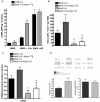Chronic treatment with angiotensin-(1-7) improves renal endothelial dysfunction in apolipoproteinE-deficient mice
- PMID: 21371005
- PMCID: PMC3130944
- DOI: 10.1111/j.1476-5381.2011.01295.x
Chronic treatment with angiotensin-(1-7) improves renal endothelial dysfunction in apolipoproteinE-deficient mice
Abstract
Background and purpose: ApolipoproteinE-deficient [apoE (-/-)] mice, a model of human atherosclerosis, develop endothelial dysfunction caused by decreased levels of nitric oxide (NO). The endogenous peptide, angiotensin-(1-7) [Ang-(1-7)], acting through its specific GPCR, the Mas receptor, has endothelium-dependent vasodilator properties. Here we have investigated if chronic treatment with Ang-(1-7) improved endothelial dysfunction in apoE (-/-) mice.
Experimental approach: ApoE (-/-) mice fed on a lipid-rich Western diet were divided into three groups and treated via osmotic minipumps with either saline, Ang-(1-7) (82 µg·kg(-1) ·h(-1) ) or the same dose of Ang-(1-7) together with D-Ala-Ang-(1-7) (125 µg·kg(-1) ·h(-1) ) for 6 weeks. Renal vascular function was assessed in isolated perfused kidneys.
Key results: Ang-(1-7)-treated apoE (-/-) mice showed improved renal endothelium-dependent vasorelaxation induced by carbachol and increased renal basal cGMP production, compared with untreated apoE (-/-) mice. Tempol, a reactive oxygen species (ROS) scavenger, improved endothelium-dependent vasorelaxation in kidneys of saline-treated apoE (-/-) mice whereas no effect was observed in Ang-(1-7)-treated mice. Chronic treatment with D-Ala-Ang-(1-7), a specific Mas receptor antagonist, abolished the beneficial effects of Ang-(1-7) on endothelium-dependent vasorelaxation. Renal endothelium-independent vasorelaxation showed no differences between treated and untreated mice. ROS production and expression levels of the NAD(P)H oxidase subunits gp91phox and p47phox were reduced in isolated preglomerular arterioles of Ang-(1-7)-treated mice, compared with untreated mice, whereas eNOS expression was increased.
Conclusion and implications: Chronic infusion of Ang-(1-7) improved renal endothelial function via Mas receptors, in an experimental model of human cardiovascular disease, by increasing levels of endogenous NO.
© 2011 The Authors. British Journal of Pharmacology © 2011 The British Pharmacological Society.
Figures




Similar articles
-
Vasoprotective and atheroprotective effects of angiotensin (1-7) in apolipoprotein E-deficient mice.Arterioscler Thromb Vasc Biol. 2010 Aug;30(8):1606-13. doi: 10.1161/ATVBAHA.110.204453. Epub 2010 May 6. Arterioscler Thromb Vasc Biol. 2010. PMID: 20448208
-
Angiotensin-(1-7)-induced Mas receptor activation attenuates atherosclerosis through a nitric oxide-dependent mechanism in apolipoproteinE-KO mice.Pflugers Arch. 2018 Apr;470(4):661-667. doi: 10.1007/s00424-018-2108-1. Epub 2018 Jan 20. Pflugers Arch. 2018. PMID: 29352340
-
An oral formulation of angiotensin-(1-7) reverses corpus cavernosum damages induced by hypercholesterolemia.J Sex Med. 2013 Oct;10(10):2430-42. doi: 10.1111/jsm.12262. Epub 2013 Jul 24. J Sex Med. 2013. PMID: 23890028
-
Angiotensin (1-7) and Alamandine: Similarities and differences.Pharmacol Res. 2016 Sep;111:820-826. doi: 10.1016/j.phrs.2016.07.025. Epub 2016 Jul 22. Pharmacol Res. 2016. PMID: 27456244 Review.
-
Vascular actions of Ang 1-7 and Ang 1-8 through EDRFs and EDHFs in non-diabetes and diabetes mellitus.Nitric Oxide. 2025 Jun;156:9-26. doi: 10.1016/j.niox.2025.02.003. Epub 2025 Mar 1. Nitric Oxide. 2025. PMID: 40032212 Review.
Cited by
-
Prolonged treatment with angiotensin 1-7 improves endothelial function in diet-induced obesity.J Hypertens. 2013 Apr;31(4):730-8. doi: 10.1097/HJH.0b013e32835ecbe5. J Hypertens. 2013. PMID: 23425706 Free PMC article.
-
Angiotensin-(1-7): new perspectives in atherosclerosis treatment.J Geriatr Cardiol. 2015 Nov;12(6):676-82. doi: 10.11909/j.issn.1671-5411.2015.06.014. J Geriatr Cardiol. 2015. PMID: 26788046 Free PMC article. Review.
-
International Union of Basic and Clinical Pharmacology. XCIX. Angiotensin Receptors: Interpreters of Pathophysiological Angiotensinergic Stimuli [corrected].Pharmacol Rev. 2015 Oct;67(4):754-819. doi: 10.1124/pr.114.010454. Pharmacol Rev. 2015. PMID: 26315714 Free PMC article. Review.
-
Angiotensin II-induced mitochondrial Nox4 is a major endogenous source of oxidative stress in kidney tubular cells.PLoS One. 2012;7(7):e39739. doi: 10.1371/journal.pone.0039739. Epub 2012 Jul 9. PLoS One. 2012. PMID: 22808054 Free PMC article.
-
Mas receptor deficiency augments angiotensin II-induced atherosclerosis and aortic aneurysm ruptures in hypercholesterolemic male mice.J Vasc Surg. 2019 Nov;70(5):1658-1668.e1. doi: 10.1016/j.jvs.2018.11.045. Epub 2019 Mar 6. J Vasc Surg. 2019. PMID: 30850299 Free PMC article.
References
-
- Arruda RM, Peotta VA, Meyrelles SS, Vasquez EC. Evaluation of vascular function in apolipoprotein E knockout mice with angiotensin-dependent renovascular hypertension. Hypertension. 2005;46:932–936. - PubMed
-
- Benter IF, Yousif MH, Dhaunsi GS, Kaur J, Chappell MC, Diz DI. Angiotensin-(1-7) prevents activation of NADPH oxidase and renal vascular dysfunction in diabetic hypertensive rats. Am J Nephrol. 2008;28:25–33. - PubMed
-
- Brooker G, Harper JF, Terasaki WL, Moylan RD. Radioimmunoassay of cyclic AMP and cyclic GMP. Adv Cyclic Nucleotide Res. 1979;10:1–33. - PubMed
-
- Cai H, Harrison DG. Endothelial dysfunction in cardiovascular diseases: the role of oxidant stress. Circ Res. 2000;87:840–844. - PubMed
Publication types
MeSH terms
Substances
LinkOut - more resources
Full Text Sources
Medical
Miscellaneous

